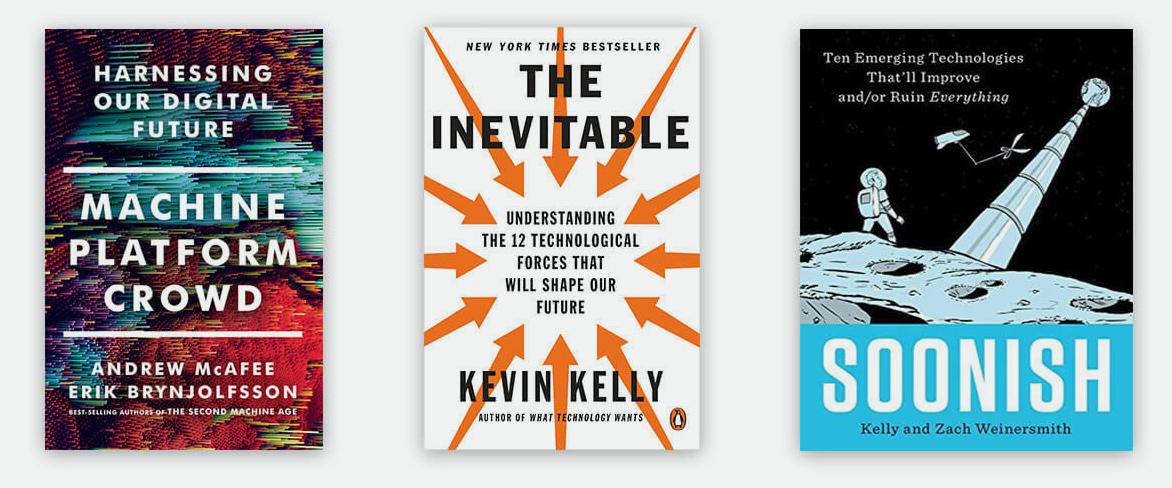
Book Review
Robots? Inevitable and Soon: Read These Now!
What's on our reading list
Bring on the future! Here are a few books that our builders have been buzzing about. And rest assured, Slalom Build receives no compensation from any book sales. We just really like 'em!

Machine, Platform, Crowd: Harnessing Our Digital Future
By Andrew McAfee and Erik Brynjolfsson
Building on the success of their previous book, The Second Machine Age, Andrew McAfee and Erik Brynjolfsson in Machine, Platform, Crowd plunge deeper into the seismic digital shifts shaping our future. Those changes are beyond the ability of anyone to accurately predict with any precision, and, to their credit, the authors stay away from the specific, offering more of a broad framework for understanding what’s coming. They have a knack for the apt, unexpected anecdote, as when they describe how ML combined with 3D printing can revolutionize things most of us don't think about – like thermostats for household appliances. They’re conscious of fears – for example the fear that robots will replace humans in some industries – but counter with a solidly more optimistic view. Humans will need to reimagine how they do certain tasks, they argue, letting go of the things machines can do better (synthesizing massive amounts of data) and focusing on the things humans do best (empathy and anything requiring emotional intelligence). Indeed, the authors see the power of humans as something we've barely begun to explore in the “Crowd” section of the book that explores the ways the hive mind can be unleashed on a whole host of issues. In all it’s an interesting, entertaining, thought-provoking read for anyone who builds.
Check it out
The Inevitable: Understanding the 12 Technological Forces That Will Shape Our Future
By Kevin Kelly
In The Inevitable, Kevin Kelly follows an approach similar McAfee and Brynjolfsson, avoiding specific predictions in favor of illuminating larger trends. The 12 forces he explores here – which he tags with one-word names like “Cognifying,” “Flowing,” and “Screening” – are at times in danger of becoming too abstract to be helpful. “Remixing” is a concept he stretches past its power to be insightful. And yet Kelly has a way of bringing his account back to something relatable and specific. “Becoming,” for example, is not a Zen principle but rather concerns the move away from fixed products to a subscription model of ever-improving services. In this book, we again hear an endorsement for the power of crowd-sourcing. In the chapter “Sharing,” about collaboration on a mass scale, Kelly writes, “On my imaginary Sharing Meter Index we are still at 2 out of 10.” However, not all chapters are equally convincing. In “Tracking,” Kelly concedes that “Ubiquitous surveillance is inevitable,” but waves away privacy concerns a bit too casually. Still, Kelly's visionary enthusiasm for the future is a buoyant force that's impossible to resist. That's especially true in the final chapter "Beginning," which outlines a vision of a planetary system connecting all humans in peace. That's something we could definitely use more of.
Check it out
Soonish: Ten Emerging Technologies That'll Improve and/or Ruin Everything
By Kelly Weinersmith and Zach Weinersmith
Filled with cartoons and mischievous wit, Soonish is the most entertaining of these three books. This is not a surprise given Zach Weinersmith's background as the creator of the popular webcomic Saturday Morning Breakfast Cereal. Topics covered with varying degrees of seriousness include 3D printed food, nuclear-powered toasters, and “re-pooping” (don't ask). If the thread sometimes gets lost in the need for constant yucks, there's an acerbic realism to this book that gives it intellectual ballast. What makes the whole thing work is research: humor is always yoked to data and real-world stories. Unlike the basically optimistic outlooks of the other two books, Soonish, true to its subtitle (Technologies That'll Improve and/or Ruin Everything), turns a clear eye to the destructive power of technology. On the improve/ruin spectrum, the authors’ awe of the possibilities for emerging technology, from space elevators to robotic construction, ultimately comes down firmly on the side of the former. It seems the future should be eagerly anticipated, rather than feared.